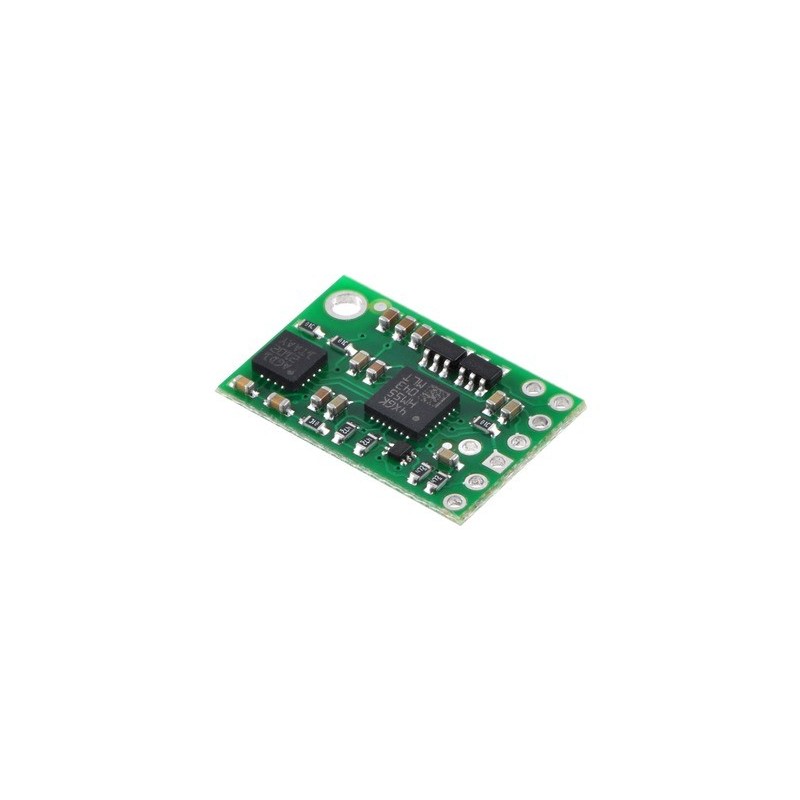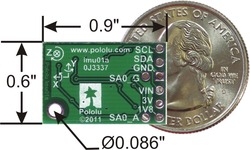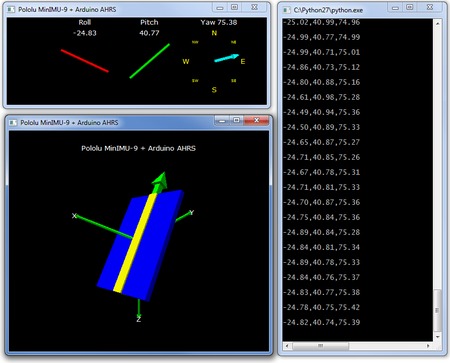- Out-of-Stock

MinIMU-9 Gyro, Accelerometer, and Compass (L3G4200D and LSM303DLM Carrier)
The Pololu MinIMU-9 is an inertial measurement unit (IMU) that packs an L3G4200D 3-axis gyro and an LSM303DLM 3-axis accelerometer and 3-axis magnetometer onto a tiny 0.9” × 0.6” board. An I2C interface accesses nine independent rotation, acceleration, and magnetic measurements that can be used to calculate the sensor’s absolute orientation. The MinIMU-9 board includes voltage regulators and a level-shifting circuit that allows operation from 2.6 to 5.5 V, and the 0.1” pin spacing makes it easy to use with standard solderless breadboards and 0.1” perfboards.
Discontinuation notice: This board is being replaced by the newer MinIMU-9 v2 L3GD20 and LSM303DLHC carrier, which offers improved magnetic sensing resolution, a wider acceleration measurement range, and gyro measurements that are more resistant to audio noise and vibrations. The new version is also 25% smaller than the original. The MinIMU-9 v2 is pin-compatible with the previous version, but the mounting hole location has changed, and the new ICs have different I˛C addresses and configuration registers, so code written to interface with the MinIMU-9 will need to be modified to work with the MinIMU-9 v2. This original version will be discontinued when stock runs out and is not recommended for new designs.
 |
The Pololu MinIMU-9 is a compact (0.9? ? 0.6? ? 0.1?) board that combines ST’s L3G4200D 3-axis gyroscope and LSM303DLM 3-axis accelerometer and 3-axis magnetometer to form an inertial measurement unit (IMU); we therefore recommend careful reading of the L3G4200D datasheet (1MB pdf) and the LSM303DLM datasheet (519k pdf) before using this product. These sensors are great ICs, but their small packages make them difficult for the typical student or hobbyist to use. They also operate on multiple voltage supplies that make interfacing with 3.3 or 5 V systems challenging. The MinIMU-9 addresses these issues by incorporating additional electronics, including two voltage regulators and a level-shifting circuit, while keeping the overall size as compact as possible. The board ships fully populated with its SMD components, including the L3G4200D and LSM303, as shown in the product picture.
The L3G4200D and the LSM303 have many configurable options, including dynamically selectable sensitivities for the gyro, accelerometer, and magnetometer, as well as a choice of output data rates for each sensor. The two ICs can be accessed through a shared I˛C/TWI interface, allowing all three sensors to be addressed individually via a single clock line and a single data line. The nine independent rotation, acceleration, and magnetic readings (sometimes called 9DOF) provide all the data needed to make an attitude and heading reference system (AHRS). With an appropriate algorithm, a microcontroller or computer can use the data to calculate the orientation of the MinIMU-9 board; the gyro can be used to very accurately track rotation on a short timescale, while the accelerometer and compass can help compensate for gyro drift over time by providing an absolute frame of reference. The respective axes of the two chips are aligned on the board to facilitate these sensor fusion calculations. (For an example of such a system using an Arduino, see the picture below and the Sample Code section at the bottom of this page.)
 |
| Visualization of AHRS orientation calculated from MinIMU-9 readings. |
|---|
The carrier board includes two voltage regulators that provide the 1.8 V and 3 V required by the L3G4200D and LSM303, allowing the module to be powered from a single 2.6 – 5.5 V supply. The regulator outputs are available on the 1V8 and 3V pins and can supply almost 150 mA and 300 mA, respectively, to external devices. The breakout board also includes a circuit that shifts the I˛C clock and data lines to the same logic voltage level as the supplied VIN, making it simple to interface the board with 3.3 V or 5 V systems, and the board’s 0.1? pin spacing makes it easy to use with standard solderless breadboards and 0.1? perfboards.
A 6?1 strip of 0.1? header pins and a 6?1 strip of 0.1? right-angle header pins are included, as shown in the picture below. You can solder the header strip of your choice to the board for use with custom cables or solderless breadboards, or you can solder wires directly to the board itself for more compact installations.
 |
A minimum of four connections are necessary to use the MinIMU-9: VIN, GND, SCL, and SDA. VIN should be connected to a 2.6 – 5.5 V source, GND to 0 volts, and SCL and SDA should be connected to an I˛C bus operating at the same logic level as VIN.
|
|
| PIN | Description |
|---|---|
| SCL | Level-shifted I˛C clock line: HIGH is VIN, LOW is 0 V |
| SDA | Level-shifted I˛C data line: HIGH is VIN, LOW is 0 V |
| GND | The ground (0 V) connection for your power supply. Your I˛C control source must also share a common ground with this board. |
| VIN | This is the main 2.6 – 5.5 V power supply connection. The SCL and SDA level shifters pull the I˛C bus high bits up to this level. |
| 3V | Regulated 3.0 V output. Almost 300 mA is available to power external components. |
| 1V8 | Regulated 1.8 V output. Almost 150 mA is available to power external components. |
| SA0_G | Gyro I˛C slave address least significant bit; pulled high by default. Most applications can leave this pin disconnected. |
| SA0_A | Accelerometer I˛C slave address least significant bit; pulled low by default. Most applications can leave this pin disconnected. |
The data ready and interrupt pins of the L3G4200D and the LSM303DLM are not accessible on the MinIMU-9; if you need these outputs, consider using our L3G4200D carrier and LSM303DLM carrier boards.
 |
The above schematic shows the additional components the carrier board incorporates to make the L3G4200D and LSM303 easier to use, including the voltage regulators that allow the board to be powered from a single 2.6 – 5.5 V supply and the level-shifter circuit that allows for I˛C communication at the same logic voltage level as VIN. This schematic is also available as a downloadable pdf: MinIMU-9 schematic (36k pdf).
The L3G4200D and LSM303DLM readings can be queried and the devices can be configured through the I˛C bus. The three sensors (the L3G4200D gyro and the LSM303DLM accelerometer and magnetometer) act as slave devices on the same I˛C bus (i.e. their clock and data lines are tied together to ease communication). Additionally, level shifters on the I˛C clock (SCL) and data lines (SDA) enable I˛C communication with microcontrollers operating at the same voltage as VIN (2.6 – 5.5V). A detailed explanation of the protocols used by each device can be found in the L3G4200D datasheet (1MB pdf) and the LSM303DLM datasheet (519k pdf), and more detailed information about I˛C in general can be found in NXP’s I˛C-bus specification (371k pdf).
The gyro, accelerometer, and magnetometer each have separate slave addresses on the I˛C bus. The gyro and accelerometer’s 7-bit slave addresses have their least significant bit (LSb) determined by the voltage on the SA0_G and SA0_A pins, respectively. The carrier board pulls SA0_G to 1.8 V and SA0_A to ground through 4.7kΩ resistors, setting the gyro’s slave address to 1101001b and the accelerometer’s slave address to 0011000b by default. If the gyro’s selected slave address happens to conflict with some other device on your I˛C bus, you can drive SA0_G low to set the LSb to 0; similarly, you can drive SA0_A high (by connecting it to 1.8 V) to set the LSb of the accelerometer’s slave address to 1. The magnetometer’s slave address is 0011110b and cannot be changed.
In our tests of the MinIMU-9, we were able to communicate with both chips at clock frequencies up to 400 kHz; higher frequencies might work but were not tested. The chips themselves and carrier board do not meet of some requirements to make the devices compliant with I˛C fast mode. They are missing 50 ns spike suppression on the clock and data lines, and additional pull-ups on the clock and data lines might also be necessary to achieve compliant signal timing characteristics.
We have written a basic L3G4200D Arduino library and LSM303 Arduino library that make it easy to interface the MinIMU-9 with an Arduino. The libraries make it simple to configure the sensors and read their raw gyro, accelerometer, and magnetometer data.
For a demonstration of what you can do with this data, you can turn an Arduino connected to a MinIMU-9 into an attitude and heading reference system, or AHRS, with this Arduino program. It uses the data from the MinIMU-9 to calculate estimated roll, pitch, and yaw angles, and you can visualize the output of the AHRS with a 3D test program on your PC (as shown in a screenshot above). This software is based on the work of Jordi Munoz, William Premerlani, Jose Julio, and Doug Weibel.
The datasheets provide all the information you need to use the sensors on the MinIMU-9, but picking out the important details can take some time. Here are some pointers for communicating with and configuring the L3G4200D and LSM303DLM that we hope will get you up and running a little bit faster:
We carry several inertial measurement and orientation sensors. The table below compares their capabilities:
| Product Name | Sensors | Estimation | Other | |||||
| Gyros (3x) | Accels (3x) | Mag (3x) | Roll | Pitch | Yaw | Quaternion | Enclosure | |
| Pololu MinIMU-9 v2 |
 |
 |
 |
|||||
| CHR-UM6-LT Orientation Sensor |
 |
 |
 |
 |
 |
 |
 |
|
| CHR-UM6 Orientation Sensor |
 |
 |
 |
 |
 |
 |
 |
 |
 |
Wixel Shield for Arduino + Wixel Pair + USB cable |
 |
Wixel Pair + USB Cable |
 |
Free Elektor magazine December 2011 |
Manufacturer BTC Korporacja sp. z o. o. Lwowska 5 05-120 Legionowo Poland sprzedaz@kamami.pl 22 767 36 20
Responsible person BTC Korporacja sp. z o. o. Lwowska 5 05-120 Legionowo Poland sprzedaz@kamami.pl 22 767 36 20
Micro SDHC memory card with 128GB capacity, class 10 with adapter. Kingston SDCS / 128GBSP
No product available!
No product available!
No product available!
Raspberry computer case: Pi 3 model B +, Pi 3 model B, Pi 2 model B and Pi 1 model B + in black color with metal
No product available!
The special construction of the braid facilitates installation in all conditions. z28423
No product available!
Cable with USB plugs type A and microUSB type B 2.0, cable length 3 m. LANBERG CA-USBM-10CC-0030-BK
No product available!
No product available!
The Adaprox LKWSW201 is a wireless Zigbee switch that enables remote control of devices in a smart home. It features two buttons, each supporting three actions: single click, double click, and long press, allowing you to assign different functions to each button. Powered by batteries (2 x AAA) and with compact dimensions (51 x 51 x 16.5 mm), the switch is easy to install and integrate into home automation systems.
No product available!
No product available!
No product available!
No product available!
No product available!
A set dedicated to control BLDC motors. It consists of the X-NUCLEO-IHM07M1 module with the L6230 controller, the NUCLEO-F302R8 development board, and the BLDC motor and power supply. STMicroelectronics P-NUCLEO-IHM002
No product available!
Development board with the PSoC5LP ARM Cortex system. Equipped with two processors: the CY8C5868LTI-LP039 debugger / programmer and the system supporting the application code CY8C5888AXI-LP096. Both processors are based on the Cortex-M3 core and have 256kB flash memory, 64kB SRAM and 2kB EEPROM. Sparkfun DEV-13714
No product available!
No product available!
No product available!

MinIMU-9 Gyro, Accelerometer, and Compass (L3G4200D and LSM303DLM Carrier)
